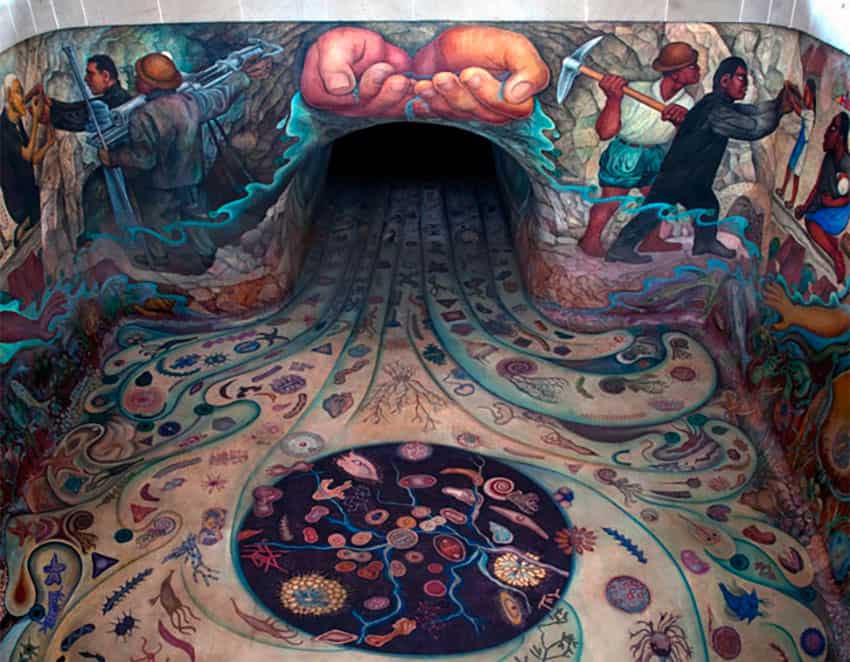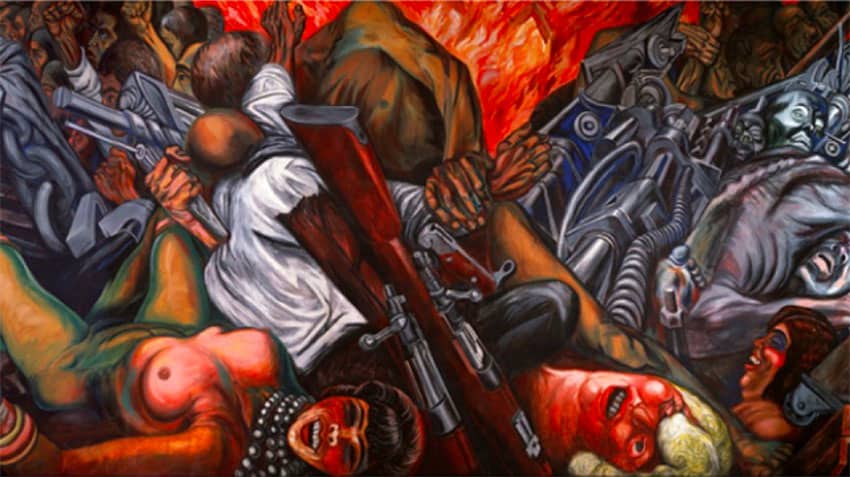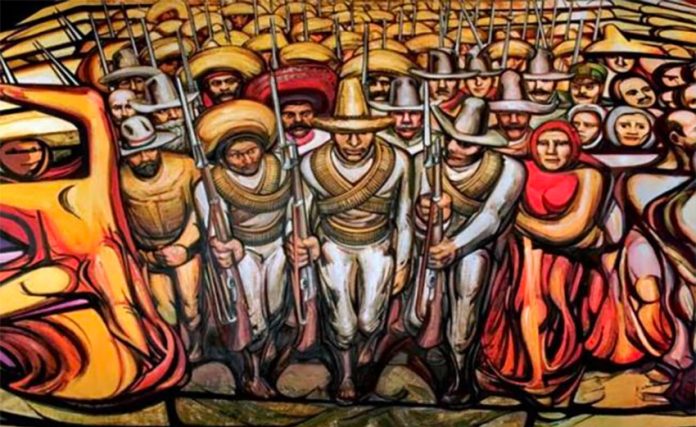The murals of Mexico City have become such an integral part of the city’s image it’s hard to imagine a time when they weren’t colorfully decorating the walls of so many public buildings.
The fact is that the majority of these murals were created less than 100 years ago, from 1920 to 1950, when the country and city were promoting public art as a way to empower, educate and enlighten citizens in a post-revolutionary Mexico.
Mexican muralism could be said to stretch all the way back to artistic expressions of pre-Hispanic tribes followed by the deeply religious murals created by the Catholic Church to convert local indigenous peoples. But most references to Mexican muralism point to the populist art movement of the early 20th century that was also, in a way, an attempt at conversion.
The post-revolution government of Mexico and in particular the secretary of education at the time, José Vasconcelos, wanted to win over the hearts and minds of citizens to the goals of the Mexican Revolution, to teach them the history of their nation and to instill a sense of pride of their mestizo identity.
He reached out to now-famous figures like Diego Rivera, José Clemente Orozco and David Siqueiros as well as lesser known painters like Ramón Alva de la Calnal, Federico Cantú, Rufino Tamayo and Dr. Atl (Gerardo Munillo) to help him bring art to the people.

Each of these painters made their own unique mark on the muralist movement in Mexico and the work of each can be seen on the walls and courtyards of some of Mexico City’s most striking buildings.
A great place to start is the San Ildefenso College, once the National Preparatory School and one of the first muralist projects to be sponsored by the Mexican government. There you can see the larger-than-life murals by Orozco, Rivera, Siqueiros, Jean Charlot, Ramón Alva de la Canal, Fermin Revueltas and Fernando Leal.
Follow this up with a trip to the Secretariat of Education building where you can see work by Rivera and Siqueiros as well as Raul Anguiano and Manuel Felguerez. This building and its art are just as impressive and infinitely less crowded than the National Palace just a few blocks away.
The latter houses what has become the most well-known mural outside of Mexico, Diego Rivera’s History of Mexico. The central stairwell mural and the subsequent murals lining several hallways took Rivera 22 years to complete and depict centuries of Mexican history following pre-Hispanic tribes through the conquest, independence and revolution, ending with a vision for the post-revolution era.
Since you’re already downtown you might as well stop by and see Rufino Tamayo’s The Birth of Nationality on the walls of the Bellas Artes, a stunning piece of art deco architecture that also houses murals by Rivera, Orozco, Siqueiros, Jorge Gonzales Camarena, Roberto Montenegro and Manuel Rodríguez Lozano.
The permanent collection of the National Art Museum, right across the street, has various small pieces (paintings, not murals) by many of these muralists before the they were charged with making these massive public art installations.

The campus of Mexico’s national university, UNAM, in the south of the city, is also home to a wide swath of public art by muralists. There you can see David Siqueiros’ The people to the University, the University to the People; Juan O’Gorman’s A Historical Representation of the Culture, which covers the exterior of the university’s central library; Rivera’s The University, the Family and Sports in Mexico on the University Olympic Stadium; The Return of Quetzalcóatl by José Chávez Morado on the south exterior wall of the Luis Unikel Library; The Conquest of Energy, also by Morado, on the Alfonso Caso Auditorium; and Life, Death Mestizaje and the Four Elements by Francisco Eppens on the medical faculty building.
While you are south of the centro, stop by the Carrillo Gil Museum in San Ángel to see their ample collection of Orozco’s work.
For a deeper dive into the painters and their lives, there are spaces that still ring with the echoes of their voices and are smudged with their colorful fingerprints. Visit the Anahuacalli Museum created by Diego Rivera to showcase his love of pre-Hispanic culture and filled with ancient artifacts and some of the pre-sketches of his most famous work.
You can also stop by the Blue House where he and fellow painter Frida Kahlo lived and imagine yourself sitting in his sun-lit office dreaming about the next big project. Or head over to the couple’s Museo Casa Estudio Diego Rivera y Frida Kahlo for a peek at their workshops and into their creative process.
One of my absolute favorite Rivera murals is inside the second section of Chapultepec Park at the Cárcamo de Dolores, once a part of the city’s hydraulic system. Rivera’s mural Water, Source of Life, which once hid below the water line, is one of his most lyrical and beautiful in my opinion.
The Rufino Tamayo Museum, instead of being a collection of his work is actually a collection of the modern and contemporary pieces that this muralist collected during his lifetime. The museum is one of our best for contemporary art and if you want to dig in to Tamayo the artist contact the museum for a separate appointment, as they are the home to his personal archive. Also check out his mural at the National Museum of Anthropology, Mural Dualidad.
The personal library and archive of David Siqueiros is located in the Sala de Arte Público Siqueiros in Polanco which has a museum and a research library open by appointment. Nearby you can see his massive From Porfirismo to the Revolution, in Chapultepec Castle. Check out this list in Spanish for some other lesser-known spots where you can see his work, except for the Polyforum Siqueiros, the site of Siqueiros’ final mural, as it’s no longer open to the public and can only be seen by peeking above a construction fence that now surrounds it.
If you just want to feel the essence of the trend maker, pass by the Ex-Convent of the Merced that Dr. Atl squatted in for a few years, creating his own artists’ colony. There are remnants of his mural Vista panorámica de la ciudad de Puebla on the walls, but unfortunately the ex-convent is currently closed to the public. You could also stop by his tombstone at the Panteon Civil de Dolores here in the city.
These are only a handful of options for creating a full-on muralism itinerary. If you don’t want to go it alone, there are several tours that focus on the movement and its biggest players, including the Mexico a Pie walking tour. Contact local art expert Natalia Zerbato to set up a private tour and for a look at today’s new muralism in Mexico City check out the Street Art Chilango street art tour in the Roma and Condesa or contact local street artist Claudio Erre aka Remix, who brings you along to paint a street mural at his side.
Lydia Carey is a freelance writer based in Mexico City and a frequent contributor to Mexico News Daily.
